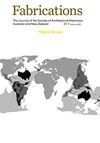Australia: Modern Architectures in History
IF 0.3
0 ARCHITECTURE
Fabrications-The Journal of the Society of Architectural Historians Australia and New Zealand
Pub Date : 2022-05-04
DOI:10.1080/10331867.2022.2093454
引用次数: 0
Abstract
particularly highlighted in her investigation of the residents’ unsanctioned renovations of dilapidated apartments and walk-out basements. Schwenkel shows that an entrepreneurial urbanisation arose, especially amongst women, whereby residents constructed shops in the walk-out basements and adhoc markets and stalls in Quang Trung’s common spaces. Schwenkel’s intent in every facet of Building Socialism is to extend and democratise the objects of scholarship, and overturn commonplace narratives. The architectural historian to which Building Socialism refers most frequently is Esra Akcan, and Schwenkel cites both Architecture in Translation: Germany, Turkey, and the Modern House, 2012, and Open Architecture: Migration, Citizenship, and the Urban Renewal of Berlin-Kreuzberg, 2018 several times. Schwenkel adopts Akcan’s notion of the translation of built form between cultures and extends it to include habitation and affect (6). This corresponds to Schwenkel’s larger intellectual project of moving scholarship on buildings away from the discussion purely of high cultural objects to the lived experience of residents and users. Building Socialism rejects the notion of uniform socialist cities, especially assumptions about uniformity and drabness of life in socialist mass housing. Building Socialism shows that “people in Vietnam did not unconditionally accept modernist utopian design; they reworked and translated it, ideologically and architecturally” (321). Quang Trung emerges as a vibrant place, with a plurality of social life and unique spatial qualities that a more limited methodological palette may have left undocumented. As such, Building Socialism has much that can inform contemporary writing of architectural history.澳大利亚:历史上的现代建筑
她在调查居民未经批准对破旧公寓和地下室进行翻新时特别强调了这一点。Schwenkel表明,创业型城市化兴起,尤其是在女性中,居民们在露天地下室建造商店,在广中的公共空间建造临时市场和摊位。施温克尔在建设社会主义的各个方面的意图都是扩大学术对象并使其民主化,并推翻司空见惯的叙事。建筑社会主义最常提到的建筑历史学家是埃斯拉·阿克坎,施温克尔多次引用了《翻译中的建筑:德国、土耳其和现代之家》(2012年)和《开放建筑:移民、公民身份和柏林克罗伊茨贝格的城市更新》(2018年)。施温克尔采用了阿克坎关于建筑形式在不同文化之间的翻译的概念,并将其扩展到包括居住和情感(6)。这与施温克尔的更大的智力项目相对应,即将对建筑的研究从纯粹的高级文化物品的讨论转移到居民和用户的生活体验。建设社会主义拒绝统一的社会主义城市的概念,尤其是关于社会主义群众住房生活的统一性和单调性的假设。建设社会主义表明,“越南人民并没有无条件地接受现代主义乌托邦设计;他们在意识形态和建筑上对其进行了重新设计和翻译”(321)。Quang Trung是一个充满活力的地方,有着多元的社会生活和独特的空间品质,而更有限的方法论调色板可能没有记录这些品质。因此,《建设社会主义》有许多内容可以为当代建筑史写作提供信息。
本文章由计算机程序翻译,如有差异,请以英文原文为准。
求助全文
约1分钟内获得全文
求助全文
来源期刊

CiteScore
0.50
自引率
25.00%
发文量
26
 求助内容:
求助内容: 应助结果提醒方式:
应助结果提醒方式:


